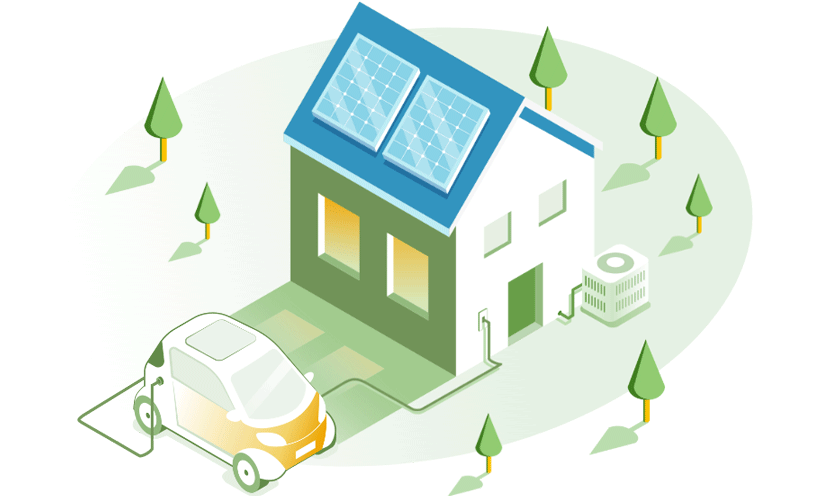
SP Energy Networks has been working with Ofgem and the Energy Networks Association (ENA) to unlock around £300m to support the transition to Net Zero and deliver a green economic recovery from Covid-19.
Earlier this year we launched a six week call for evidence across our two distribution network areas (Central and Southern Scotland and Cheshire, Merseyside and North & Mid Wales) in order to identify green projects that we believe can benefit from quick deployment of network investment in the next two years.
We are delighted to confirm that we have been awarded more than £60m of funding through the Green Recovery investment programme to take forward 40 of these projects, 18 of which are in Scotland, 16 in England and six in Wales.
The projects we are taking forward over the next 18 months will provide additional electrical capacity to enable the connection of a host of low carbon technologies (LCTs) such as electric vehicles (EVs) and heat pumps.
The investment announced today will create over 650MW of electrical capacity across our networks. We expect this to enable around 500 rapid or ultra-rapid vehicle chargers, 4,000 domestic heat pumps as well as numerous other significant connections. Examples include:
- Super-fast electric vehicle charging infrastructure in nine service stations along the M56, M6, M62, M74 and M8 motorways.
- The installation of eight brand new substations including the construction of a new £6m substation near the COP26 venue in Glasgow to create a lasting COP26 legacy by enabling future green developments and the connection of LCTs into the grid
- In North West England, two new substations will support the prestigious Runcorn Station Quarter regeneration development by enabling the connection of EV charging infrastructure.
- And in North Wales, we are investing in a project to remove a constraint that will enable a community community hydro facility, giving domestic energy customers in the area the opportunity to use locally produced renewable energy.
Frank Mitchell, CEO of SP Energy Networks, said: “To tackle climate change we’re electrifying transport, decarbonising heating and buildings and connecting more wind and solar energy generation than ever before. Our network must be ready to support these changes and set the foundations for a Net Zero future.
“We have ambitious plans to revolutionise the distribution network between 2023 and 2028 – we’re going to reinforce or replace hundreds of miles of cables, upgrade more than 800 substations and bring new technologies online to help us manage the increased energy flowing through our grid.
“The projects we have announced today are welcome, but they only represent the tip of the iceberg for our energy networks. Make no mistake, this is an infrastructure project to rival anything this country has delivered in recent memory.”
“These projects were selected because they are shovel-ready, can be delivered at speed and will help our communities to take important steps forward on their journey to Net Zero.”
Green Recovery Priorities
The call for evidence was designed to understand and validate the state of readiness of proposals and plans that developers, local authorities and other stakeholders are considering around the areas we have identified. This will enable us to create a priority order of network investment (reinforcement) and implement this over the next two to three years. It will also inform longer term network development in RIIO-ED2[1] and beyond.
Priority has been given to the projects allocated funding on the basis of the following criteria:
- Utilisation (e.g. how much of the capacity might be used in the near term – evidence of user demand or need).
- Deliverability (how quickly infrastructure and solutions could be completed).
- Value for money. This would consider:
- Firstly, the cost of the particular scheme relative to the prospective utilisation, including the potential capability of the scheme to provide flexibility or other DSO services; and
- Secondly, any wider benefits the scheme may have (e.g. supporting the delivery of government policy, wider regional investment it may unlock and job creation)
[1] RIIO-ED2 Sector Specific Methodology Decision | Ofgem
Funding
The Green Recovery funding has been made available to distribution networks by Ofgem. Any funding made available is limited to the cost of the distribution network solutions and not as a contribution towards the cost of the technologies being installed, or the cost of any final service connection required to the local network. The normal competition in connections process will be available to third parties for the final service connection. Please note that this funding is separate to recent Government funding announcements in the 10-point plan, however we do expect that this scheme will be complimentary to and support those Government funding arrangements going forward.
If you have been unsuccessful in your application for funding in the initial round of Green Recovery investment, then we will be happy to consider proposals that were unsuccessful on this occasion in any future Green Recovery funding rounds. We believe there is considerable scope for the process to be repeated and will be working with both Ofgem and the ENA to make a strong case for that. Applicants may also submit their evidence to DNOs for inclusion in the RIIO-ED2 business plan, which will be submitted to Ofgem and cover investment in the networks during the period 2023-2028.